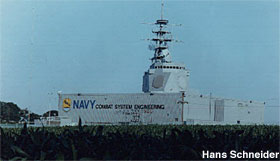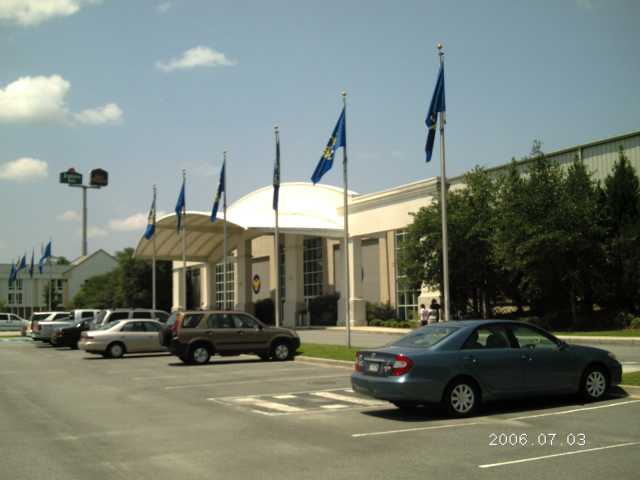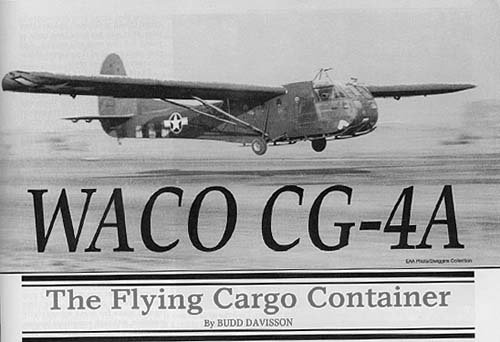Notice: This post will evolve and expand this evening (8/18) and now into 8/19. Lots of issues here, just in case someone decides we need to protect out coastline. I’m starting it now to get the thought process going, but if you’re interested, check back late tonight or tomorrow for more of my insights.
Got this from Milblogs and the poster there, Eagle1, has more at his site, including a 7/26/06 post.
I feel like adding my two cents and I will “fisk” myself, using my own comments I posted on Eagle1’s blog:

A thorny issue indeed. Many years gone by, there were NIKE AJAX and HERCULES, as well as BOMARC missile sites all around the US, near major cities to defeat the threat of manned bombers.
 I had one of these!
I had one of these!
I grew up near the Renton, WA Boeing plant, and a family friend got me a factory model of a IM-99 BOMARC missile, complete with the TEL.
How can we possibly manage a coast line defense without massive expeditures, let alone the acquisitions of real estate in all of the places we would need to park a RADAR/SAM Site?
First issue: While ballistic missiles go up, with enough altitude to show well beyond local horizon, we’ll need outward looking RADAR systems to continually scanning the horizon, on the azimuths of the expected threat….At the very least, we’d have to place many RADAR sites on the East, Gulf and West coastlines for protection. We could decline to place them on the Northern and Southern border, as the threat is postualted, in this case, to be sea launched. We would have to acquire plots of land, every so many vulnerable miles to allow siting the defense systems. The effort and the cost would be staggering to cover all three coasts, so some hard decisions would have to be made, as to which places were of “high value.” Who would make this decision matrix up?
If we choose to only protect some areas, then, as demonstrated by the terrorists, the tactics are to go for the weak spots. What if a “tramp steamer” was modified to carry North Korean manufactred SCUDs? As a result, the non-/less defended areas would most likely become the targets of choice for those wishing to make a point. The follow on outcry would parallel that of the aftermath of Hurricane Katrina, with citizens with loud voices, would have expected that every single square inch of American soil and neighborhood was protected with 100% certainty. The human wreckage would be bad enough, but the political fallout would be horrific, as we seem we are no longer able to understand the Federal Government cannot take care of everyone, everywhere.
It’s not out of the question, these days, that other than nation sates with military power, have access and support (financial, logistical and training) to field and use weapons of increasing size and complexity. The Israelis found this out when a CS-801 anti-ship missile was launched from the vicinity of Beriut.
 MinuteMan ICBM
MinuteMan ICBM
Second issue: Land acquisition. My father worked for years in Montana, North and South Dakota (and other states in the vicinity I’m sure) as an Army Corps of Engineers land appraiser. He travelled most of the time in my early years, finding and procuring land for Minute Man silos. I do recall discussions, once in a while about “condemning” property back then, and have come to understand years later that’s what we have come to know as “eminent domain.” I’m also sure, the cost wasn’t cheap for that level of national security to be put in place.
While I was on active duty, my dad visited me in Virginia Beach, there to work on getting the local community to grant easements for the land around Oceana Master Jet Base. The Navy wanted agriculture only. That was when Viginia Beach was the fastest growing city in the US, during the Reagan military build up. With the building of Lynnhaven Mall in early 80’s, there was concern such a large shopping center would be located essentailly under the landing and approach patern for a busy air station, not to mention, more and more farm land was being sold, and both commercial and residential building was taking place around there. The response from the City Council/community was: “If you want the land to be free of buildings…then buy it!” What would happen now if we had to purchase beachfront property, particularly when it’s near population centers (to be defended) at today real estate pricing? Think about the cost…more comments later in this article related to this topic.
I’m wondering if RCA is proposing the SPY-1 Series, in a block house, with a MK-41 VLS matrix in a self contained blockhouse arrangement.
Call it “MOTS” (Military Off the Shelf), for purposes of discussion, but…there are systems developed, tested, deployed and documented in our hands right now. The ideal shopping list of equipment would be from those items deployed aboard Navy combatants, as they are designed for maximum capability, using minimum space and limited resources. The logistics chain is already established and the only issue would be quantities, from a contracting standpoint.
 AEGIS Engineering Site near the NJ Turnpike – the “Cornfield Cruiser”
AEGIS Engineering Site near the NJ Turnpike – the “Cornfield Cruiser”
I mentioned the AN/SPY-1(series) phased array RADAR, and the AN/SPG-99 Illimuniators because they have proven themselves with several decades of service. The proof of concept on this type of shore based installation has been in place for many years, being nicknamed the “Cornfield Cruiser” near the RCA plant in Moorstown, NJ. The MK-41 Vertical Launching System (VLS) missile matrix is already certified to operate with several types of anti-aircraft weapons. Other choice might be the Rolling Airframe Missile with the modified MK-15 Close In Weapons System mounting for point defense of the RADAR site itself. Toss in the AN/USG-2(V) Cooperative Engagement System (CEC) capability for intercommunications between nodes. All this stuff is in service right now.
 MK-116 Rolling Airframe Missile Firing
MK-116 Rolling Airframe Missile Firing
All you’d have to solve is the radio frequency interference (RFI) issues when operating high powered RADAR. The issue there is when the US and the Soviet Union put over the horizon early warning radars on the line in the late 70’s, the exceptionally high strength signal “splattered about the RF spectrum, and Amatuer Radio Operators referred to the signals as “the Woodpecker” for it’s characteristic interference signal in serval bands. These sites would play havoc with local TV and radio reception, a necessary side effect for the trade off of defense.
Another particulalry interesting issue involved in placing such things in a neighborhood, since explosives ordnance will be present, is the blast radius of detonating ordnance in the event of that unplanned circumstance. One other project my father worked on was the possibility of building an ammo pier on Guam, in one of the bays on the SW part of the island (this was during the height of the VN war, and the B-52s out of Anderson AFB hauled a lot of bombs). I do recall sitting at the kitchen table, looking at aerial phots of the area, with concentric circles superimposed on them. The inner circle was the area where houses would be leveled, the second, I believe was major strutural damage and the third, where glass windows would be blown out. Of course they had to plan for an entire ship load of ordnance exploding, not merely something like 16 SM-3 anti-air missiles. In any case, this is not an issue most real estate agents have to consider. In other words, the physical space for the site, in terms of land procurement is one issue, but then having a cleared, safe area, in the event of explosions, adds to the acreage needed. It would be costly.
 Vindeby Wind Farm, Denmark from www.windpower.com
Vindeby Wind Farm, Denmark from www.windpower.com
Questions:
1) If we can’t get people in Martha’s Vineyard to allow wind generators on towers off the beach, how will we get them to accept the placement of a phased array and a booster disgarding missile system “just down the block” from their house?
Even when last years devestating hurricanes helped (once again) to point out our dependence on foreign oil, not only did the beach residents of MA say “NOT IN MY FIELD OF VIEW (will you construct those ugly wind towers)!”, but the CA and FL congressmen banded together, across party lines, to ensure no oil drilling would occur with 250 miles of a beach (unless you’re Chinese oil rigs working for Cubans). So if too high gas prices won”t allow measures to solve the problem, would the concept of placing systems as decribed above work any better? And, in actual fact, it’s not like you can just lobby to place your defensive system (for your locale) in a less affluent neighborhood, because defense is about location and geometry, and cares not even a little for the economic topography….
2) If we don’t want to fund manpower to sit as virtual TAOs at each site (wow…job opportunity for retired SWOs!), is there a plan to have a centrally located node with the RADAR/ESM sensor data being transmittded to where the decision maker will sit a 24/7/365 watch?
3) If the manpower is too much money for the taxpayers liking, will “we” accept software control of engagements (which…is already a proven function in several systems)? Will we choose an MS operating system to manage the functions, and if so, will Bill Gates allow the review of the software at the code level?
Ah, more to blog on….I have some background in the field…
Software safety. Big issue. Worthy of tackling when I can pull out the mental coal shovel, so I’ll end this tale for the night. Check back for more tomorrow (late day)



























